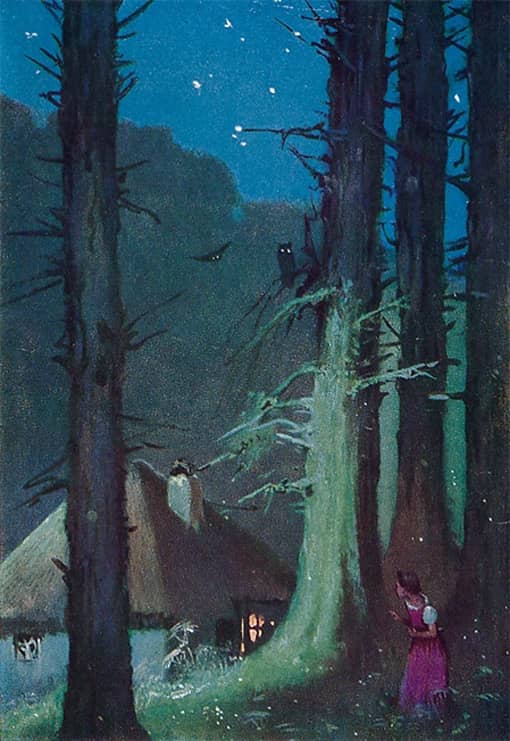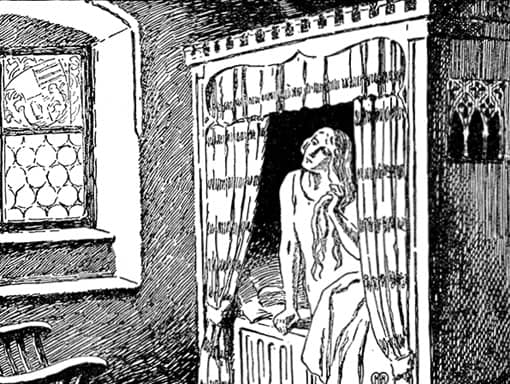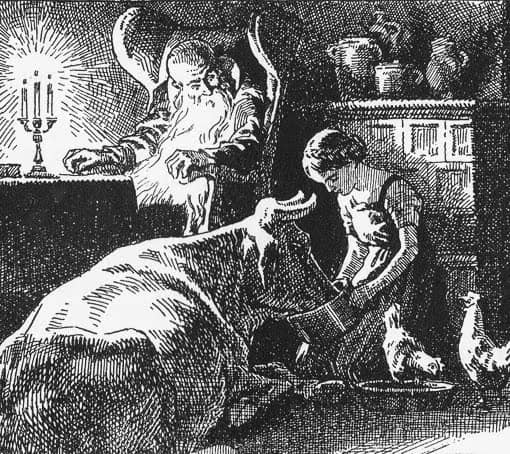Reading time: 14 min
A poor wood-cutter lived with his wife and three daughters in a little hut on the edge of a lonely forest. One morning as he was about to go to his work, he said to his wife, „Let my dinner be brought into the forest to me by my eldest daughter, or I shall never get my work done, and in order that she may not miss her way,“ he added, „I will take a bag of millet with me and strew the seeds on the path.“ When, therefore, the sun was just above the center of the forest, the girl set out on her way with a bowl of soup, but the field-sparrows, and wood-sparrows, larks and finches, blackbirds and siskins had picked up the millet long before, and the girl could not find the track. Then trusting to chance, she went on and on, until the sun sank and night began to fall. The trees rustled in the darkness, the owls hooted, and she began to be afraid. Then in the distance she perceived a light which glimmered between the trees. „There ought to be some people living there, who can take me in for the night,“ thought she, and went up to the light. It was not long before she came to a house the windows of which were all lighted up.

She knocked, and a rough voice from inside cried, „Come in.“ The girl stepped into the dark entrance, and knocked at the door of the room. „Just come in,“ cried the voice, and when she opened the door, an old gray-haired man was sitting at the table, supporting his face with both hands, and his white beard fell down over the table almost as far as the ground. By the stove lay three animals, a hen, a cock, and a brindled cow. The girl told her story to the old man, and begged for shelter for the night. The man said:
„Pretty little hen,
Pretty little cock,
And pretty brindled cow,
What say ye to that?“
„Duks,“ answered the animals, and that must have meant, „We are willing,“ for the old man said, „Here you shall have shelter and food, go to the fire, and cook us our supper.“ The girl found in the kitchen abundance of everything, and cooked a good supper, but had no thought of the animals. She carried the full dishes to the table, seated herself by the gray-haired man, ate and satisfied her hunger. When she had had enough, she said, „But now I am tired, where is there a bed in which I can lie down, and sleep?“ The animals replied:
„Thou hast eaten with him,
Thou hast drunk with him,
Thou hast had no thought for us,
So find out for thyself where thou canst pass the night.“
Then said the old man, „Just go upstairs, and thou wilt find a room with two beds, shake them up, and put white linen on them, and then I, too, will come and lie down to sleep.“

The girl went up, and when she had shaken the beds and put clean sheets on, she lay down in one of them without waiting any longer for the old man. After some time, however, the gray-haired man came, took his candle, looked at the girl and shook his head. When he saw that she had fallen into a sound sleep, he opened a trap-door, and let her down into the cellar. Late at night the wood-cutter came home, and reproached his wife for leaving him to hunger all day.
„It is not my fault,“ she replied, „the girl went out with your dinner, and must have lost herself, but she is sure to come back to-morrow.“ The wood-cutter, however, arose before dawn to go into the forest, and requested that the second daughter should take him his dinner that day. „I will take a bag with lentils,“ said he; „the seeds are larger than millet, the girl will see them better, and can’t lose her way.“ At dinner-time, therefore, the girl took out the food, but the lentils had disappeared. The birds of the forest had picked them up as they had done the day before, and had left none. The girl wandered about in the forest until night, and then she too reached the house of the old man, was told to go in, and begged for food and a bed. The man with the white beard again asked the animals,
„Pretty little hen,
Pretty little cock,
And pretty brindled cow,
What say ye to that?“
The animals again replied „Duks,“ and everything happened just as it had happened the day before. The girl cooked a good meal, ate and drank with the old man, and did not concern herself about the animals, and when she inquired about her bed they answered,
„Thou hast eaten with him, Thou hast drunk with him,
Thou hast had no thought for us,
To find out for thyself where thou canst pass the night.“
When she was asleep the old man came, looked at her, shook his head, and let her down into the cellar. On the third morning the wood-cutter said to his wife, „Send our youngest child out with my dinner today, she has always been good and obedient, and will stay in the right path, and not run about after every wild humble-bee, as her sisters did.“ The mother did not want to do it, and said, „Am I to lose my dearest child, as well?“
„Have no fear,‘ he replied, „the girl will not go astray. She is too prudent and sensible; besides I will take some peas with me, and strew them about. They are still larger than lentils, and will show her the way.“ But when the girl went out with her basket on her arm, the wood-pigeons had already got all the peas in their crops, and she did not know which way she was to turn. She was full of sorrow and never ceased to think how hungry her father would be, and how her good mother would grieve, if she did not go home. At length when it grew dark, she saw the light and came to the house in the forest. She begged quite prettily to be allowed to spend the night there, and the man with the white beard once more asked his animals,
„Pretty little hen,
Pretty little cock,
And beautiful brindled cow,
What say ye to that?“
„Duks,“ said they. Then the girl went to the stove where the animals were lying, and petted the cock and hen, and stroked their smooth feathers with her hand, and caressed the brindled cow between her horns, and when, in obedience to the old man’s orders, she had made ready some good soup, and the bowl was placed upon the table, she said, „Am I to eat as much as I want, and the good animals to have nothing?

Outside is food in plenty, I will look after them first.“ So she went and brought some barley and stewed it for the cock and hen, and a whole armful of sweet- smelling hay for the cow. „I hope you will like it, dear animals,“ said she, „and you shall have a refreshing draught in case you are thirsty.“ Then she fetched in a bucketful of water, and the cock and hen jumped on to the edge of it and dipped their beaks in, and then held up their heads as the birds do when they drink, and the brindled cow also took a hearty draught.

When the animals were fed, the girl seated herself at the table by the old man, and ate what he had left. It was not long before the cock and the hen began to thrust their heads beneath their wings, and the eyes of the cow likewise began to blink. Then said the girl, „Ought we not to go to bed?“
„Pretty little hen,
Pretty little cock,
And pretty brindled cow,
What say ye to that?“
The animals answered:
„Duks. Thou hast eaten with us,
Thou hast drunk with us,
Thou hast had kind thought for all of us,
We wish thee good-night.“
Then the maiden went upstairs, shook the feather-beds, and laid clean sheets on them, and when she had done it the old man came and lay down on one of the beds, and his white beard reached down to his feet. The girl lay down on the other, said her prayers, and fell asleep. She slept quietly till midnight, and then there was such a noise in the house that she awoke. There was a sound of cracking and splitting in every corner, and the doors sprang open, and beat against the walls. The beams groaned as if they were being torn out of their joints, it seemed as if the staircase were falling down, and at length there was a crash as if the entire roof had fallen in. As, however, all grew quiet once more, and the girl was not hurt, she stayed quietly lying where she was, and fell asleep again.
But when she woke up in the morning with the brilliancy of the sunshine, what did her eyes behold? She was lying in a vast hall, and everything around her shone with royal splendor. On the walls, golden flowers grew up on a ground of green silk, the bed was of ivory, and the canopy of red velvet, and on a chair close by, was a pair of shoes embroidered with pearls. The girl believed that she was in a dream, but three richly clad attendants came in, and asked what orders she would like to give? „If you will go,“ she replied, „I will get up at once and make ready some soup for the old man, and then I will feed the pretty little hen, and the cock, and the beautiful brindled cow.“ She thought the old man was up already, and looked round at his bed; he, however, was not lying in it, but a stranger.
And while she was looking at him, and becoming aware that he was young and handsome, he awoke, sat up in bed, and said, „I am a King’s son, and was bewitched by a wicked witch, and made to live in this forest, as an old gray-haired man. No one was allowed to be with me but my three attendants in the form of a cock, a hen, and a brindled cow. The spell was not to be broken until a girl came to us whose heart was so good that she showed herself full of love, not only towards mankind, but towards animals – and that thou hast done, and by thee at midnight we were set free, and the old hut in the forest was changed back again into my royal palace.“ And when they had arisen, the King’s son ordered the three attendants to set out and fetch the father and mother of the girl to the marriage feast. „But where are my two sisters?“ inquired the maiden. „I have locked them in the cellar, and to-morrow they shall be led into the forest, and shall live as servants to a charcoal-burner, until they have grown kinder, and do not leave poor animals to suffer hunger.“
 Learn languages. Double-tap on a word.Learn languages in context with Childstories.org and Deepl.com.
Learn languages. Double-tap on a word.Learn languages in context with Childstories.org and Deepl.com.Backgrounds
Interpretations
Adaptions
Summary
Linguistics
„The Hut in the Forest“ is a fairy tale collected by the Brothers Grimm, also known as Jacob and Wilhelm Grimm. They were German scholars, linguists, and cultural researchers who collected and published numerous folktales and legends during the early 19th century. Their collection, known as „Grimm’s Fairy Tales“ or „Children’s and Household Tales“ (originally „Kinder- und Hausmärchen“ in German), first appeared in 1812 and has become one of the most famous and influential compilations of folktales in the world.
The Brothers Grimm were part of the Romantic movement in Germany, which was characterized by a renewed interest in folklore, mythology, and the idea of a shared national culture. They aimed to preserve the oral traditions of German-speaking regions by collecting stories from various sources, including friends, family members, and other storytellers. While the Grimms are often associated with children’s literature, their original collection contained many stories that were considered unsuitable for children due to their dark and violent content. Over time, however, the stories have been adapted and modified to cater to a younger audience, and the Brothers Grimm have become synonymous with classic fairy tales.
„The Hut in the Forest“ is one of the lesser-known stories from the Grimm collection, but it carries similar themes and moral lessons as many of their other tales. Like other Grimm fairy tales, the story contains elements of magic, transformation, and the struggle between good and evil. The tale emphasizes the importance of kindness, compassion, and inner beauty, reinforcing the values that were important in the society and culture of the time.
„The Hut in the Forest“ can be interpreted in several ways, emphasizing different themes and moral lessons. Here are three possible interpretations:
The importance of kindness and compassion: The story highlights the importance of being kind and compassionate not only to fellow humans but also to animals. The youngest daughter’s caring nature is what ultimately breaks the spell and transforms the old man back into a king’s son. This interpretation teaches the readers to treat all living beings with respect and love.
The consequences of selfishness and neglect: The two older sisters, who only care for their own well-being and ignore the needs of the animals, end up being punished for their actions. They are locked in the cellar and later made to serve a charcoal-burner until they learn their lesson. This interpretation emphasizes that selfishness and neglect can lead to negative consequences and that one must think of others‘ well-being in addition to their own.
Inner beauty and true worth: The youngest daughter’s good-heartedness is what ultimately saves her and transforms the old man and the hut. In contrast, her older sisters, who may be physically attractive, lack the inner beauty that makes the youngest daughter truly valuable. This interpretation teaches the importance of valuing a person’s character and inner qualities, rather than focusing solely on superficial attributes.
Overall, „The Hut in the Forest“ is a rich and thought-provoking tale that underscores the importance of kindness, compassion, and inner beauty. It serves as a reminder that our actions have consequences, and that our true worth lies in how we treat others, including animals.
„The Hut in the Forest“ is a classic fairy tale from the Brothers Grimm that has been adapted and retold in various forms over the years. Here are some notable adaptations of the tale.
„Hansel and Gretel“ (1893): The well-known fairy tale „Hansel and Gretel“ by the Brothers Grimm is often seen as an adaptation of „The Hut in the Forest“. In „Hansel and Gretel“, two children are abandoned in the forest and come across a candy house owned by a witch who plans to eat them. The similarities between the two stories are striking, and it’s possible that „Hansel and Gretel“ was inspired by „The Hut in the Forest“.
„The Hut in the Woods“ (1929): This silent film directed by Hans Richter is a surreal and experimental adaptation of „The Hut in the Forest“. The film features dreamlike imagery and explores themes of isolation, fear, and the subconscious mind.
„The Juniper Tree“ (1990): This dark and eerie film by director Nietzchka Keene is a loose adaptation of „The Hut in the Forest“ that incorporates elements from other Grimm fairy tales as well. The story follows a young girl who is murdered by her stepmother and comes back to life as a bird.
„Into the Woods“ (2014): This popular musical by Stephen Sondheim and James Lapine combines several fairy tales, including „The Hut in the Forest“, into one sprawling narrative. The story follows a baker and his wife as they try to lift a curse that has prevented them from having children. Along the way, they encounter characters from various fairy tales, including Little Red Riding Hood and Cinderella.
„The Witch“ (2015): This horror film directed by Robert Eggers draws inspiration from „The Hut in the Forest“ as well as other fairy tales and historical sources. The story follows a Puritan family in 17th-century New England who are haunted by a malevolent witch that lives in the woods.
These adaptations of „The Hut in the Forest“ demonstrate the enduring popularity and versatility of the Grimm fairy tales.
„The Hut in the Forest“ is a fairy tale by the Brothers Grimm about a poor wood-cutter who lives with his wife and three daughters in a small hut on the edge of a lonely forest. One day, the wood-cutter asks his eldest daughter to bring his dinner into the forest. He scatters millet seeds on the path to guide her, but the birds eat the seeds, causing the girl to lose her way. She stumbles upon a mysterious hut, occupied by an old gray-haired man and three animals: a hen, a cock, and a brindled cow. The girl is allowed to stay the night but is dropped into the cellar while she sleeps, due to her lack of concern for the animals.
The next day, the second daughter faces a similar fate after losing her way, as the birds also eat the lentil seeds her father scatters for her guidance. Like her sister, she ends up at the hut and is dropped into the cellar. Finally, the youngest daughter is sent with her father’s dinner, and despite the birds eating the peas scattered for her, she finds the hut. Unlike her sisters, she shows kindness to the animals and feeds them before eating her meal.
That night, a great noise breaks the spell cast by a wicked witch, transforming the old man into a handsome king’s son, and the hut into a royal palace. The prince explains that the spell could only be broken by a girl with a kind heart toward both humans and animals. The king’s son and the youngest daughter marry, and her parents are invited to the palace. The older sisters are made to serve a charcoal-burner in the forest until they learn kindness and compassion for animals.
In the Brothers Grimm fairy tale „The Hut in the Forest,“ various linguistic elements contribute to its narrative structure and thematic richness. A linguistic analysis highlights the use of language in character development, thematic conveyance, and the creation of atmosphere.
Language and Character Development
Direct Speech: The tale frequently employs direct speech, which aids in character development. The wood-cutter’s instructions to his wife and daughters display his practical nature and concern for completing his work. Similarly, the old man’s repetitive inquiries to the animals emphasize his dependence on their judgment for decisions.
Repetition: The dialogue involving the animals and the old man is repeated with each daughter’s visit. This repetition creates a rhythmic pattern and reinforces the moral choices available to the daughters. Phrases such as, „Pretty little hen, Pretty little cock, And pretty brindled cow, What say ye to that?“ add to this hypnotic rhythm, and the animals’ response, „Duks,“ serves as a constant yet enigmatic permission.
Descriptive Language: The tale uses vivid descriptive language to paint the scenes, especially in the transformation from the old hut to the royal palace. Descriptions like „golden flowers grew up on a ground of green silk“ and „the bed was of ivory, and the canopy of red velvet“ create a stark contrast between the humble forest dwelling and the opulence of the palace, symbolizing the protagonist’s moral journey.
Thematic Conveyance
Kindness versus Neglect: Linguistically, the tale emphasizes the theme of kindness, particularly through the actions and words of the youngest daughter. Her speech and actions towards the animals underscore her compassionate nature, leading to the story’s resolution. Her kindness is rewarded, contrasting her sisters’ neglect, which is linguistically marked by their indifferent speech and actions.
Transformation: Transformation is a central theme, underscored by the linguistic shift from dark, rustic imagery to vibrant, regal descriptions. This shift symbolizes both physical and moral transformations, highlighting the narrative’s moral: genuine kindness and selflessness transcend and transform one’s circumstances.
Metaphoric Animal Speech: The word „Duks,“ spoken by the animals, serves as a linguistic device that bridges human and animal realms, emphasizing the interconnectedness and mutual respect between them. Despite its seemingly nonsensical nature, it serves a crucial role in decision-making within the tale.
Atmosphere and Mood
Sensory Details: The tale uses auditory imagery, such as „the trees rustled,“ „the owls hooted,“ and later, the disruptive sounds during the night in the house, to evoke a sense of mystery and tension. These sensory details immerse the reader in the protagonist’s experiences and emotions.
Symbolic Light and Darkness: Light and darkness serve as symbolic linguistic elements throughout the narrative. The discovery of the light in the forest represents hope and direction, contrasting with the confusion and fear embodied by the dark, mysterious forest.
In conclusion, the Brothers Grimm utilize various linguistic techniques in „The Hut in the Forest“ to enrich the narrative. Through direct speech, repetition, and vivid descriptions, the tale explores themes of kindness, transformation, and moral growth, while creating a dynamic atmosphere that guides the reader through the protagonist’s journey.
Information for scientific analysis
Fairy tale statistics | Value |
|---|---|
| Number | KHM 169 |
| Aarne-Thompson-Uther-Index | ATU Typ 431 |
| Translations | DE, EN, DA, ES, PT, HU, IT, JA, NL, PL, RO, RU, TR, VI, ZH |
| Readability Index by Björnsson | 33 |
| Flesch-Reading-Ease Index | 80 |
| Flesch–Kincaid Grade-Level | 8 |
| Gunning Fog Index | 10.8 |
| Coleman–Liau Index | 7.2 |
| SMOG Index | 8.1 |
| Automated Readability Index | 9 |
| Character Count | 9.829 |
| Letter Count | 7.487 |
| Sentence Count | 80 |
| Word Count | 1.914 |
| Average Words per Sentence | 23,93 |
| Words with more than 6 letters | 174 |
| Percentage of long words | 9.1% |
| Number of Syllables | 2.320 |
| Average Syllables per Word | 1,21 |
| Words with three Syllables | 58 |
| Percentage Words with three Syllables | 3% |

 Facebook
Facebook  Whatsapp
Whatsapp  Messenger
Messenger  Telegram
Telegram Reddit
Reddit














